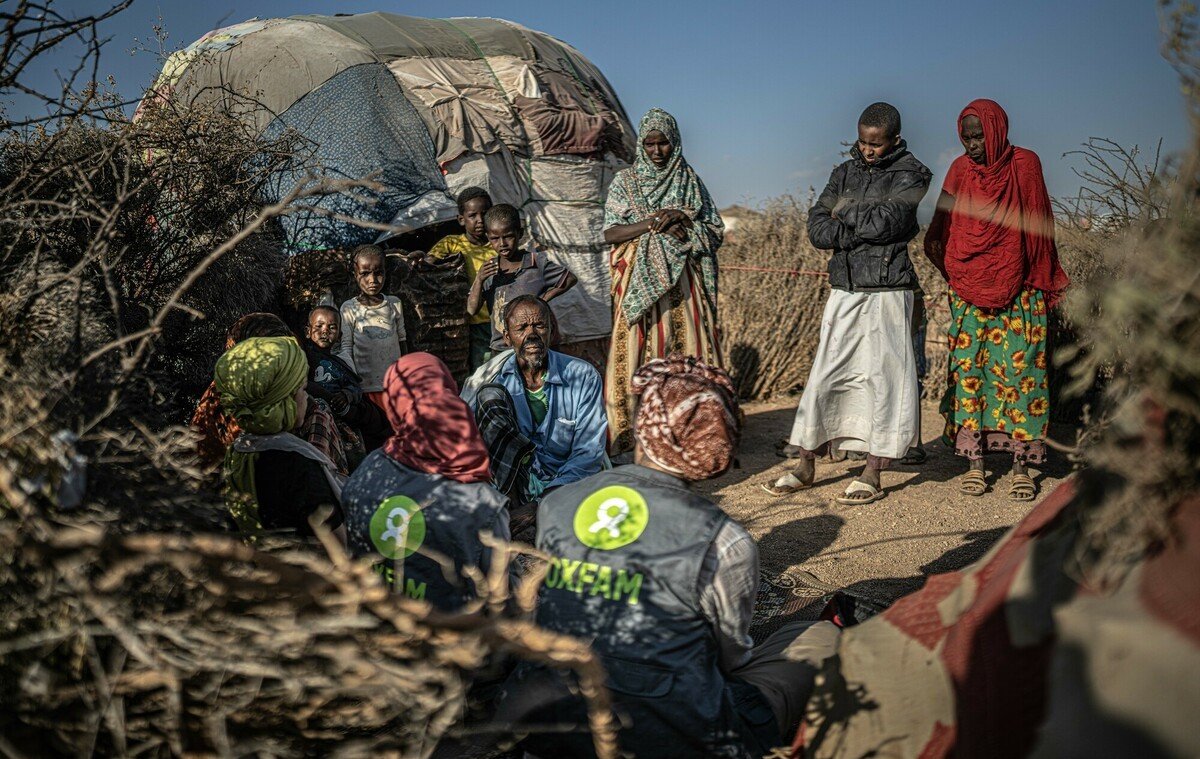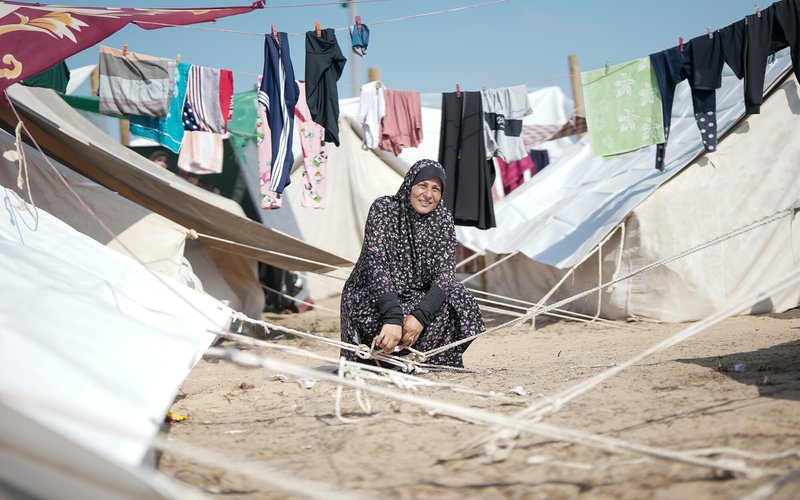From Gaza to Sudan, people are facing starvation and need urgent aid to survive.
The latest analysis on hunger in Gaza confirms famine in Gaza City and nearby areas. Famine is projected to expand to Deir al-Balah and Khan Younis by the end of September.
After 22 months of relentless conflict, over half a million people in the Gaza Strip are facing catastrophic conditions, characterized by starvation, destitution and death. Another 1.07 million people—54 percent of the population—are facing emergency levels of hunger.
At Oxfam, we’ve been focused on the fight to end hunger since our founding. So, we’re going to define what exactly is famine, what causes it, share an example of a famine, and explain how people like you can help stop famine in its tracks.
What does famine mean?
Famine is “an extreme crisis of access to adequate food.” Visible in “widespread malnutrition” and “loss of life due to starvation and infectious disease,” famine robs people of their dignity, equality, and for some—their lives.
So how do we know a famine is occurring? The Integrated Food Security Phase Classification, or IPC, is a common global scale that informs how governments and aid groups should respond when people lose reliable access to sufficient, affordable, and nutritious food. It’s a five-phase warning system to inspire urgent action before it’s too late.
For a famine to exist in a given area—Phase 5 of the acute food insecurity scale—three conditions, backed by evidence, must be met:
- 1 in 5 households faces an extreme food shortage
- High levels of acute malnutrition, a nutritional deficiency that results from inadequate energy or protein intake. This can be assessed by finding that either 30 percent of children are too thin for their height, or 15 percent of children are assessed as "wasting" based on a measurement of the mid-upper arm.
- Death rates exceed two adults or four children per day for every 10,000 people
The Israeli government has closed nearly all of the access points into Gaza, slowing the flow of aid to millions of people in need to a trickle for more than five months. The IPC classification of famine in Gaza City and nearby areas confirms what Oxfam staff and the entire humanitarian community in Gaza have been warning for months: Israel’s continued campaign of bombing and blocking aid has brought widespread deadly starvation to Palestinian families in Gaza.
(For more information on acute malnutrition and the data used to determine IPC phases, see the IPC Technical Manual.)

What causes a famine?
Famines are caused by multiple factors. Since 2020, a deadly combination of conflict, COVID-19, and climate change has dramatically increased the number of people suffering from severe hunger. When compounded by inaction or policy decisions that make people more vulnerable, famine can result and society can collapse.
In Gaza, many challenges are putting people on the brink of famine:
- Following the attack by Palestinian armed militants on October 7, Israel’s bombardment of Gaza has resulted in widespread damage to assets and infrastructure critical for health and food production and distribution.
- At the same time, widespread destruction of housing and near universal forced displacement caused families to quickly exhaust any savings and severely undermined their resilience and opportunities to make a living.
- Israel’s ongoing aid blockade on Gaza and systematic denial of commercial and humanitarian access to and within the Gaza Strip continues to impede the safe and equitable delivery of basic essentials and lifesaving humanitarian assistance.
- Aid workers in Gaza are being killed and are unable to safely deliver humanitarian aid.
Political scientist Alex de Waal calls famine a political scandal, a “catastrophic breakdown in government capacity or willingness to do what [is] known to be necessary to prevent famine.” When governments fail to prevent or end conflict—or help families prevent food shortages brought on by any reason—they fail their own people.
What is an example of a famine?
The 1984 famine in Ethiopia took the lives of 1 million people, driven in part by drought, conflict, and the policy choices of national and regional authorities. Estimates suggest around 1 million people survived thanks to the delivery of humanitarian aid.
On the evening of Tuesday, October 23, 1984, NBC Nightly News aired footage taken by an Ethiopian videographer that showed scores of deceased people on stretchers that were being taken toward makeshift graveyards. Though the scenes inspired a robust international response, the nature of that response overlooked the capacity of communities affected by the famine to help themselves.
By the next morning, Oxfam America had received over 300 calls an hour from people like you who wanted to help. During the relief effort, feeding centers provided hungry people with food rations. Makeshift hospitals supported severely dehydrated people with IVs, providing shots of tetracycline to fight infection. Oxfam delivered protein and fat-fortified biscuits to those in need that saved many lives, but some could not eat them, as their mouths were riddled with open sores because of dehydration.
“These scenes of death and dying in the famine camps in Ethiopia were beyond the American experience, beyond anyone’s comprehension,” recalls Bernie Beaudreau, an Oxfam staffer at the time.

Can famine be stopped?
Famine can be stopped—now, and in the long term. But governments and aid groups must anticipate a worsening hunger crisis, secure the resources and political will to address the root causes of hunger, and safely deliver humanitarian aid to those most in need.
In Gaza and countries like Somalia, Yemen, Ethiopia, and Madagascar, Oxfam is working to reduce the likelihood of famine with people like you. Here are some ways you can support Oxfam’s work:
- Providing clean water
- Stomach ailments from dirty water rob people of good nutrition from whatever food they can find, and young children are particularly vulnerable. That’s why Oxfam helps improve and repair wells to access clean water as well as trucks in water to areas where there is none.
- Stomach ailments from dirty water rob people of good nutrition from whatever food they can find, and young children are particularly vulnerable. That’s why Oxfam helps improve and repair wells to access clean water as well as trucks in water to areas where there is none.
- Encouraging proper sanitation
- Good sanitation and hygiene are essential for preventing the spread of diseases like cholera, Ebola, and COVID-19, which are especially deadly leading up to and during famines. Oxfam helps construct latrines and distributes hygiene items like soap so people can wash their hands.
- Good sanitation and hygiene are essential for preventing the spread of diseases like cholera, Ebola, and COVID-19, which are especially deadly leading up to and during famines. Oxfam helps construct latrines and distributes hygiene items like soap so people can wash their hands.
- Distributing food
- When food is available in markets, but might be scarce or very expensive for some, Oxfam distributes cash to help buy food. Oxfam also distributes emergency food rations when necessary.
- When food is available in markets, but might be scarce or very expensive for some, Oxfam distributes cash to help buy food. Oxfam also distributes emergency food rations when necessary.
- Planting crops
- In areas where farmers can plant crops, Oxfam supplies seeds, tools, and other assistance so people can grow their own food. We also help farmers raising livestock with veterinary services, animal feed, and in some cases, we distribute animals to farmers to help restock their herds.
- In areas where farmers can plant crops, Oxfam supplies seeds, tools, and other assistance so people can grow their own food. We also help farmers raising livestock with veterinary services, animal feed, and in some cases, we distribute animals to farmers to help restock their herds.
- Building resilience over the long-term
- We help build the capacity of local organizations to respond to emergencies like famine, shifting power from international organizations to leaders rooted in local know-how. We promote the leadership of our local partners and boost their skills to reduce suffering, risks, and losses by preparing their own communities before disasters strike.
- We help build the capacity of local organizations to respond to emergencies like famine, shifting power from international organizations to leaders rooted in local know-how. We promote the leadership of our local partners and boost their skills to reduce suffering, risks, and losses by preparing their own communities before disasters strike.
- Advocating with and for communities
- Oxfam and our supporters advocate for the resolution of conflicts and push for sufficient assistance for people affected by war and famine. Our research and advocacy also advance sustainable development in ways that help reduce the risk of future food crises and disasters.

